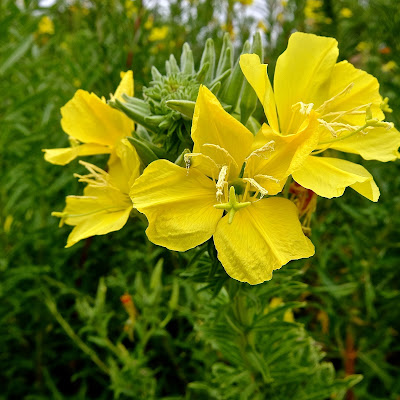 |
| RSABG Badge: photo by Cliff Hutson |
Wildflower Week
Hooker’s Evening Primrose
 |
| Oenothera elata hookeri: photo by Cliff Hutson |
Hooker’s evening primrose, Oenothera elata hookeri, is a member of a genus of about 145 species of herbaceous flowering plants native to the Americas. It is the type genus of the family Onagraceae. Common names include evening primrose, suncups, and sundrops.
The appellation “evening” comes from the habit of the blooms of many species opening in twilight. An interesting aspect of evening primroses is that their flowers open very quickly, some in under a minute. This occurs because the cells at the margins of the sepals are connected in a zipper-like structure. As the petals grow, they break through the zipper and quickly spill out.
The hookeri subspecies is native to California and also grows in much of western and central North America. It is tall for an evening primrose, reaching heights of up to six feet. It flowers from June through September with yellow blossoms that are 2 to 3 inches wide. One of the most distinctive features of the flower is the stigma, which has four branches in an X shape.
Calflora says that this plant generally inhabits moist places in coastal or somewhat inland areas at lower elevations. Other sources state that it can be found on open slopes, road banks, and grassy areas from the plains to the mountains. One nursery, which carries it, maintains that it will survive drought and flooding, sun, wind and cold.
The common name always seemed a bit risqué to me. But, it is actually named for Sir William Jackson Hooker (1785-1865), professor of botany and director of the Royal Botanical Gardens at Kew in the mid 19th century and author of several botanical works. Among his friends and colleagues were David Douglas, Thomas Nuttall, and Asa Gray, after whom he named the genus Grayia. How is that for name dropping?
